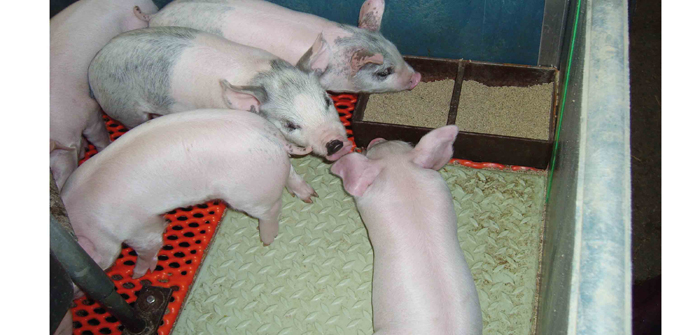Rising input prices are putting ever greater importance on keeping a lid on costs. Here, AHDB and Ireland’s Teagasc outline tips to save money
There are key areas all pig producers can review on their units to help build resilience, was the pig industry enters another challenging period. As Pig World reported last month, input costs have been rising far quicker than farmgate prices and margins are being squeezed.
The dry summer meant crop yields were down across Europe and AHDB’s market analysts say feed costs are likely to stay high in the coming months. Meanwhile, pig prices are very difficult to predict due to volatile global market conditions – all of which are out of producers’ control.
However, every producer can control what’s on their own farm and look for opportunities, however small, to reduce their cost of production. “It’s often a series of minor tweaks that add up to make an overall impact, rather than one big change,” said AHDB knowledge exchange manager Richard Bows (pictured below).
“Useful steps to take can be related to any part of the production process from gilt management to cutting feed wastage and it will depend on the individual farm.”
Ciaran Carroll (pictured below) of Teagasc, the Irish Agriculture and Food Development Authority, said: “Not all options will be suitable for all farms but the more that you can implement, the greater the potential for financial savings. The important thing is to start with the analysis of accurate records. Knowing your true costs of production is the first step to identifying where you need to focus on your farm. Include your non-feed costs too, such as labour, energy costs and loan repayments.”
REDUCING FEED WASTE
If 5% of feed is damaged and lost to dust and waste, it can cost up to £5,000/year on a 500-sow unit. This could increase to more than £20,000 if finishers are included, equating to an extra cost of 1p/kg deadweight. Producers should consider feed quality, storage and spillage to reduce wastage and improve feed conversion efficiency.
Mr Bows said: “Dust, ‘fines’ or lumps of clogged feed will affect flow rates and reduce feed intake so check that the hopper or auger mechanism isn’t damaging the feed or affecting the pellet size.
“Bagged feed should be stored in a dry area and at a suitable temperature, so avoid storing creep feed in a nursery or farrowing house, for example, as the warm temperatures can turn the feed rancid.”
There are several possible causes of feed spillage to check for. “The hopper design may be incorrect for the size of pig, overstocking may be causing uneven feeding, feeder flow rates may need adjustment or the feed bins or hoppers may need repairing.
If one broken finisher feeder was wasting, for example, 10% of the feed passing through it, the cost could be 1.2 tonnes of feed per year, given the annual throughput of a feeder is around 12 tonnes.”
Feed falling between the slats is also an expensive waste so producers could consider placing feeders on boards.
AHDB Pork has a feeder review factsheet for producers, available on its website.
FEED QUALITY AND INTAKE
Mr Bows said: “It’s also vital to review feed strategies regularly with your nutritionist or feed supplier to ensure that the diet formulation, timing of diet changes and quantities match the age of pig and growth rates. Cheapest is not always best – the value of pig performance must also be taken into consideration.”
If possible, producers should devise a way to measure the feed intake of either a whole building or individual pens. Regularly checking feed intake will help to optimise diet formulations and detect fluctuations.
ALTERNATIVE FEEDS
Alternatives, such as wet feeds and co-products, can be useful. During the last feed crisis, many pig producers maintained positive financial margins throughout because of their capacity to produce low-cost feeds and capitalise on better feed conversion efficiencies.
Alternative feeds and forage crops and some food industry co-products become more attractive as the price of cereals and soya rise. However, there are some pitfalls to be aware of – variability in the nutritional value of alternative feeds could affect animal performance if it’s not measured.
Mr Bows added: “Make sure you sample and analyse feed with help from a nutritionist to maintain the nutritional balance of the feed – and keep monitoring pig performance.”
CREEP FEEDING
Mr Carroll suggested also looking at creep and link feeding strategies. “Ask the question, are you overfeeding creep and/or link diets? Work out a feed budget, targeting 3kg creep and 5kg link usage per pig. Could you consider using a standard creep or feed a link diet instead of creep?
“Many of us are guilty of overfeeding weaner diets. Switching to a finisher diet at 32kg weight can result in significant savings if this is suitable for your unit,” he said.
IMPROVING MARKETING RETURN
Meeting the contract specification and increasing uniformity of finished pigs will help improve financial returns. The aim should be to sell as many kilograms of meat within the contract boundaries as possible, with at least 85% of pigs in the ‘optimum box’, to minimise penalties, which can reduce the overall margin per pig.
If a batch is different to normal, or highly variable, it will be more difficult for the processor to sell these pigs. Producers should set up a weighing routine to help with accurate selection to contract, perhaps weighing a few representative pigs each week in the passageway or penned beside the raceway.
Mr Bows said: “Bear in mind, though, that some variation is inevitable and achieving 100% in the box can be inefficient. So there is an economic balance that needs to be calculated between growth rates and grading.”
REVIEW SLAUGHTER WEIGHTS
The economics are generally in favour of increasing pig slaughter weights, even when feed costs are high. However, in some cases, it may become more profitable to finish pigs at a lower slaughter weight, with a reduced feed input. Before going down this route, it is essential that producers first discuss it with their contract supplier and nutritionist and carefully consider the profit margin data and calculations. There is a slaughter weight decisions table to help with this, available by searching the AHDB website.
BREEDING HERD
“There are two main areas to focus on in the breeding herd,” said Mr Carroll. “The first is your gilt pool. Are you carrying an excess number of gilts? Gilts will consume about 210kg of feed, so excess gilts could be costing you around £49 each in feed costs. Target a gilt pool of 12% of herd size.
“The second area is sow culling. Cull sow income accounts for only 2% of total sales income. Continually assess sow performance and cull unproductive sows immediately. Do not try to restore condition before sale as sows have an FCE of 7:1.
“Each empty day costs around £2.70, thus 10 extra empty days per litter could cost more than £30,000 for a 500-sow herd.”
HEALTH AND HYGIENE
Good hygiene and biosecurity are the basis of maintaining good herd health and productivity but it’s worth reviewing where improvements can be made. An underlying health issue may not be immediately obvious but can affect growth and feed conversion efficiency.
Although it can be difficult to find time, any on-farm changes to reduce cost of production will put pig businesses in a better position to weather the difficult times and see rewards when margins improve.






